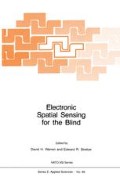Abstract
Providing electronic replacement for human visual functions is a complex problem with unanswered questions in many areas of science and technology as well as rehabilitation. The general problem and tentative lines of solution have been studied since the beginning of the century: an electronic spatial sensor was developed by 1897 (14) and technology for both a spatial sensor and a reading machine was developed by Fournier d’Albe between 1912 and 1920 (10,22).
Access this chapter
Tax calculation will be finalised at checkout
Purchases are for personal use only
Preview
Unable to display preview. Download preview PDF.
References
Armstrong, J. (1973). Summary report of the research pro-grams on electronic mobility aids. Report, Psychology Department, University of Nottingham.
Bach-y-Rita, P., Collins, C. C., Saunders, F., White, B., & Scadden, L. (1969). Vision substitution by tactile image projection. Nature, 221, 963–964.
Ballard, D. H. & Brown, C. M. (1972). Computer Vision. New Jersey: Prentice-Hall.
Brabyn, J. A. (1978). Laboratory Studies of Aided Blind Mobility. Ph.D. Thesis: University of Canterbury.
Brabyn, J. A., Collins, C. C., & Kay, L. (1981). A wide- band CTFM scanning sonar with tactile and acoustic display for persons with impaired vision (blind, diver, etc.). Proceedings of the Ultrasonic International Conference, Brighton, England.
Brabyn, J. A. & Strelow, E. R. (1977). Computer-analyzed measures of characteristics of human locomotion and mobility. Behavior Research Methods and Instrumentation, 9, 456–462.
Collins, C. C., Scadden, L. A., & Alden, A. B. (1977). Mobility studies with a tactile imaging device. Conference on Systems and Devices for the Disabled, Seattle.
Deering, M. F. (1982). Real time natural scene analysis for a blind prosthesis. Fairchild Technical Report #622.
Easton, R. D. & Jackson, R. M. (1983). Pilot test of the trisensor, a new generation sonar sensory aid. Journal of Visual Impairment & Blindness, 77, 446–449.
Fournier d’Albe, E. E. F. (1920). The optophone: An instrument for reading by ear. Nature, 105, 295–297.
Freiburger, A. M. (1967). Fabrication of obstacle detectors for the blind. Bulletin of Prosthetics Research, 10, 8.
Gibson, J. J. (1979). The Ecological Approach to Visual Perception. Boston: Houghton-Mifflin.
Guarniero, G. (1974). Experience of tactile vision. Perception, 3, 101–104.
Jansson, G. (1978). Human locomotion guided by a matrix of tactile point stimuli. In G. Gordon (Ed.), Active Touch. Oxford: Pergamon Press.
Kay, L. (1964). An ultrasonic sensing probe as a mobility aid for the blind. Ultrasonics, April-June, 106–114.
Kay, L. (1974). A sonar aid to enhance spatial perception of the blind: Engineering design and evaluation. The Radio and Electronic Engineer.
Kay, L. (1982). Spatial perception through an acoustic sensor. Report, University of Canterbury.
Kay, L., Bui, S. T., Brabyn, J. A., & Strelow, E. R. (1976). Single object sensor: A simplified binaural mobility aid. Journal of Visual Impairment & Blindness, 70, 22–24.
Maure, D. R., Mellor, C. M., & Uslan, M. (1979). AFB’s computerized travel aid: Experimenters wanted. Journal of Impairment & Blindness, 73, 380–381.
Michaels, C. F. & Carello, C. A. (1982). Direct Perception. New York: Appleton Century Crofts.
Moravec, H. P. (1982). Robot Rover: Visual Navigation. Ann Arbor: UMI Research Press.
Nye, P. W. & Bliss, J. C. (1970). Sensory aids for the blind: A challenging problem with lessons for the future. Proceedings, Institute of Electrical and Electronic Engineers, V58, 12, 1878–1898.
Pressey, N. (1977). Mowat Sensor. Focus, 11, 35–39.
Russell, L. (1965). Travel path sounder. Proceedings, Rotterdam Mobility Research Conference. New York: American Foundation for the Blind.
Strelow, E. R. (1982). Sensory aids: Commercial versus research interests. Journal of Visual Impairment & Blind-ness, 76, 241–243.
Strelow, E. R. (1985). What is needed for a theory of mobility: Direct perception and cognitive maps: Some lessons from the blind. Psychological Review, 92, 226–248.
Strelow, E. R. & Boys, J. T. (1979). The Canterbury child’s aid: A binaural spatial sensor for research with blind children. Journal of Visual Impairment & Blindness, 73, 179–184.
Strelow, E. R. & Brabyn, J. A. (1981). Use of foreground and background information in visually guided locomotion. Perception, 10, 191–198.
Strelow, E. R. & Brabyn, J. A. (1982). Use of natural sound cues by the blind to control locomotion. Perception, 11, 635–640.
Strelow, E. R. & Brabyn, J. A., & Clark, G. R. S. (1976). Apparatus for measuring and recording path velocity and direction characteristics of human locomotion. Behavior Research Methods and Instrumentation, 8, 442–446.
Valvo, A. (1971). Sight Restoration After Long-term Blindness: The Problems and Behavior Patterns of Visual Rehabilitation. New York: American Foundation for the Blind.
Warren, D. H. & Strelow, E. R. (1984). Learning spatial dimensions with a visual sensory aid: Molyneux revisited. Perception, 13, 331–350.
White, B., Saunders, F. A., Scadden, L. A., Bach-y-Rita, P., & Collins, C. C. (1970). Seeing with the skin. Perception & Psychophysics, 7, 23–27.
Author information
Authors and Affiliations
Editor information
Editors and Affiliations
Rights and permissions
Copyright information
© 1985 Springer Science+Business Media Dordrecht
About this chapter
Cite this chapter
Warren, D.H., Strelow, E.R. (1985). Historical Overview. In: Warren, D.H., Strelow, E.R. (eds) Electronic Spatial Sensing for the Blind. NATO ASI Series, vol 99. Springer, Dordrecht. https://doi.org/10.1007/978-94-017-1400-6_1
Download citation
DOI: https://doi.org/10.1007/978-94-017-1400-6_1
Publisher Name: Springer, Dordrecht
Print ISBN: 978-90-481-8293-0
Online ISBN: 978-94-017-1400-6
eBook Packages: Springer Book Archive

